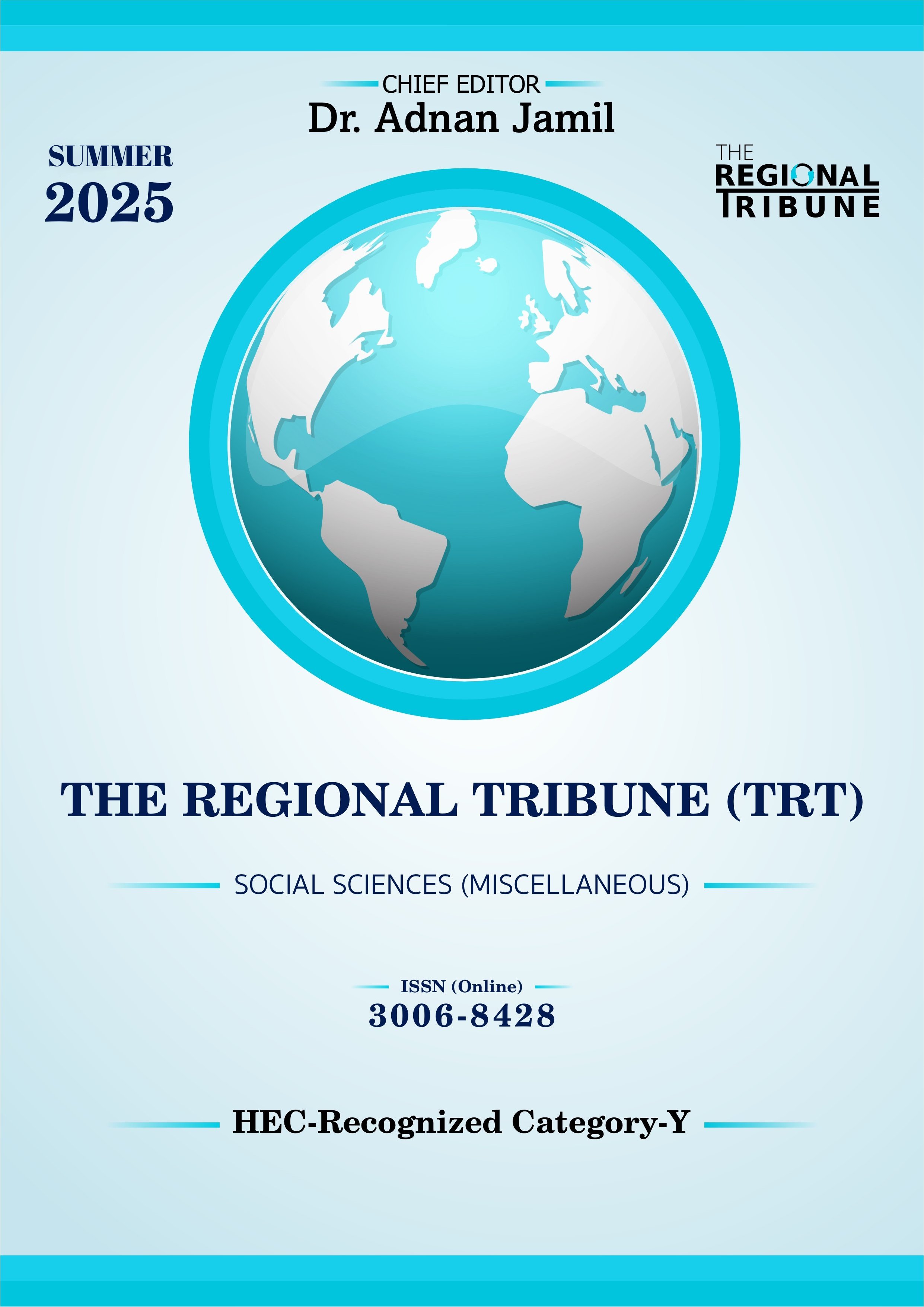Interplay of Personality Traits and Self-Regulation among Secondary School Teachers
DOI:
https://doi.org/10.55737/trt/SR25.122Keywords:
Secondary Education, Self-Regulation, Personality Traits, Conscientiousness, Emotional StabilityAbstract
Present research explored the complexity of personality characteristics concerning self-regulation at the secondary level of the teaching profession in the government sector within the city of Lahore, Pakistan. With the quantitative, correlational type of design, a convenience sample of 300 teachers (male 150 and female 150) was surveyed through a structured questionnaire. The interdependence was investigated with the use of statistical methods, such as Pearson correlation and independent samples t-tests. Outcomes showed that self-regulation had a strong, positive relationship with each of the personality traits in the Big Five, with the highest values in conscientiousness (r=0.512, p<0.001) and emotional stability (r=0.469, p<0.001). It is also noteworthy that male teachers showed higher indicators in self-regulation and personality characteristics than female ones, and teachers aged between 31 and 40 received the best results on the main variables. The research findings show that personality variables are huge predictors of the ability of a teacher to self-regulate, which is why special needs-based professional development is a necessity. The evidence suggests that self-regulatory improvement efforts can be tailored as interventions to enhance teaching effectiveness and well-being, based on the teachers' personality profiles.
References
Abbas, M., Tariq, S., & Jamil, M. (2021). Continuous Professional Development (CPD) and quality education of Primary School Teachers: A quantitative study in Lahore, Punjab. Global Educational Studies Review, VI(IV), 206–212. https://doi.org/10.31703/gesr.2021(vi-iv).21
Berkovich, I., & Eyal, O. (2021). Teachers’ Big Five personality traits, emotion regulation patterns, and moods: mediation and prototype analyses. Research Papers in Education, 36(3), 332–354. https://doi.org/10.1080/02671522.2019.1677758
Bien, A., & Selland, M. (2018). Living the stories we tell: The sociopolitical context of enacting teaching stories. Teaching and Teacher Education, 69, 85–94. https://doi.org/10.1016/j.tate.2017.10.005
Bloomfield, J., & Fisher, M. (2019). Quantitative research design. JARNA, 22(2), 27–30. https://doi.org/10.33235/jarna.22.2.27-30
Capa-Aydin, Y., Sungur, S., & Uzuntiryaki, E. (2009). Teacher self‐regulation: examining a multidimensional construct. Educational Psychology, 29(3), 345–356. https://doi.org/10.1080/01443410902927825
Dewe, P., Antoniou, A., & Cooper, C. (2017). Coping, Personality and the Workplace. Taylor and Francis.
Dignath, C., & Büttner, G. (2018). Teachers’ direct and indirect promotion of self-regulated learning in primary and secondary school mathematics classes–insights from video-based classroom observations and teacher interviews. Metacognition and Learning, 13(2), 127-157. https://doi.org/10.1007/s11409-018-9181-x
Ehm, J.-H., Hasselhorn, M., & Schmiedek, F. (2019). Analyzing the developmental relation of academic self-concept and achievement in elementary school children: Alternative models point to different results. Developmental Psychology, 55(11), 2336–2351. https://doi.org/10.1037/dev0000796
Emmer, E. T., & Evertson, C. M. (2016). Classroom management for middle and high school teachers. Pearson.
Fernet, C., Guay, F., Senécal, C., & Austin, S. (2012). Predicting intraindividual changes in teacher burnout: The role of perceived school environment and motivational factors. Teaching and Teacher Education, 28(4), 514–525. https://doi.org/10.1016/j.tate.2011.11.013
Gok, D., Bozoglan, H., & Bozoglan, B. (2021). Effects of online flipped classroom on foreign language classroom anxiety and reading anxiety. Computer Assisted Language Learning, 1–21. https://doi.org/10.1080/09588221.2021.1950191
Golzar, J., Noor, S., & Tajik, O. (2022). Convenience sampling. International Journal of Education & Language Studies, 1(2), 72–77.
Hwang, Y.-S., Noh, J.-E., Medvedev, O. N., & Singh, N. N. (2019). Effects of a mindfulness-based program for teachers on teacher wellbeing and person-centred teaching practices. Mindfulness, 10(11), 2385-2402. https://doi.org/10.1007/s12671-019-01236-1
Jamil, M., Zahra, H., & Fida, F. (2024). Integrating life skills in secondary education: Teachers’ perspectives and challenges. Journal of Social & Organizational Matters, 3(4), 01–10. https://doi.org/10.56976/jsom.v3i4.112
Jennings, P. A., & Greenberg, M. T. (2009). The prosocial classroom: Teacher social and emotional competence in relation to student and classroom outcomes. Review of Educational Research, 79(1), 491–525. https://doi.org/10.3102/0034654308325693
Mahama, I., Dramanu, B. Y., Eshun, P., Nandzo, A., Baidoo-Anu, D., & Amponsah, M. A. (2022). Personality traits as predictors of self-regulated learning and academic engagement among college students in Ghana: A dimensional multivariate approach. Education Research International, 2022, 1–12. https://doi.org/10.1155/2022/2255533
Malanchini, M., Engelhardt, L. E., Grotzinger, A. D., Harden, K. P., & Tucker-Drob, E. M. (2019). Same but different”: Associations between multiple aspects of self-regulation, cognition, and academic abilities. Journal of Personality and Social Psychology, 117(6), 1164–1188. https://doi.org/10.1037/pspp0000224
McCrae RaC, P. (2008). The five-factor theory of personality. In: Handbook of Personality: Theory and Research. 3rd ed. New York: Guildford Press.
McCrae, R. R., & Costa, P. T. (1997). Personality trait structure as a human universal. The American Psychologist, 52(5), 509–516. https://doi.org/10.1037/0003-066x.52.5.509
Mohammad, N., Sajid, S. M., & Jamil, M. (2022). Teachers’ empowerment and organisational commitment: A perceived perspective of secondary school teachers in Punjab. Global Regional Review, VII(II), 127–135. https://doi.org/10.31703/grr.2022(vii-ii).12
Naseer, H., Muhammad, Y., & Jamil, M. (2022). Critical thinking skills in Pakistan studies textbook: Qualitative content analysis. Pakistan Journal of Social Research, 4(3), 744-755. https://doi.org/10.52567/pjsr.v4i03.764
Pandey, R. (2024). Advancing Teacher Education: A Holistic Approach Across Primary, Secondary, and Higher Levels. Management, 7(2), 22-30p.
Richardson, P. W., & Watt, H. M. (2018). Teacher professional identity and career motivation: A lifespan perspective. In Research on teacher identity: Mapping challenges and innovations (pp. 37-48). Springer.
Roberts, B. W., Chernyshenko, O. S., Stark, S., & Goldberg, L. R. (2005). The structure of Conscientiousness: An empirical investigation based on seven major personality questionnaires. Personnel Psychology, 58(1), 103–139. https://doi.org/10.1111/j.1744-6570.2005.00301.x
Sáez-Delgado, F., López-Angulo, Y., Mella-Norambuena, J., Baeza-Sepúlveda, C., Contreras-Saavedra, C., & Lozano-Peña, G. (2022). Teacher self-regulation and its relationship with student self-regulation in secondary education. Sustainability, 14(24), 16863. https://doi.org/10.3390/su142416863
Sautelle, E., Bowles, T., Hattie, J., & Arifin, D. N. (2015). Personality, resilience, self-regulation and cognitive ability relevant to teacher selection. Australian Journal of Teacher Education (Online), 40(4), 54-71. https://search.informit.org/doi/10.3316/ielapa.080852592705061
Senler, B., & Sungur-Vural, S. (2013). Pre-service science teachers’ teaching self-efficacy in relation to personality traits and academic self-regulation. The Spanish Journal of Psychology, 16(E12), E12. https://doi.org/10.1017/sjp.2013.22
Zimmerman, B. J. (2000). Attaining self-regulation: A social cognitive perspective. In Handbook of self-regulation (pp. 13-39). Elsevier.
Downloads
Published
Issue
Section
License

This work is licensed under a Creative Commons Attribution-NonCommercial 4.0 International License.



